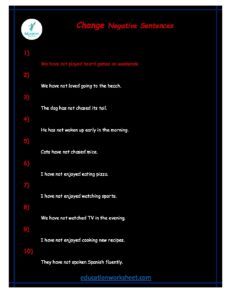Change Simple Past tense to Present Perfect tense 20 worksheets
Description of Change Simple Past tense to Present Perfect tense
Understanding the Present Perfect Tense”
In this section, we’ll delve into the concept of the present perfect tense, explaining what it is and when to use it. We’ll provide examples to clarify its usage and demonstrate its relevance in various situations.
“Transforming Change Simple Past tense to Present Perfect tense”
This segment will guide you through the process of changing sentences in simple past tense to present perfect tense. We’ll break down the rules, conjugations, and common patterns to help you make this transformation accurately and effectively.
change simple past to present perfect tense form negative

“Practice and Application of Change Simple Past tense to Present Perfect tense”
Here, we’ll present exercises and examples for you to practice transforming simple past tense sentences into present perfect tense. We encourage you to apply what you’ve learned and reinforce your understanding through hands-on practice.
“Common Pitfalls and Tips of Change Simple Past tense to Present Perfect tense“
In this section, we’ll highlight common mistakes to avoid and offer tips to enhance your ability to convert simple past tense to present perfect tense seamlessly. Understanding the nuances and potential challenges will further solidify your grasp of this important grammatical aspect.
Change simple present to present perfect tense from negative

“Enhancing Your Language Skills of Change Simple Past tense to Present Perfect tense”
The final part of the blog will focus on how mastering the present perfect tense can elevate your language skills, improve your writing, and enhance your overall communication. We’ll discuss its impact and why it’s essential to have a strong command of this aspect of grammar.
Understanding the Change Simple Past tense to Present Perfect Negative Tense”
In this section, we’ll explore the nuances of the past perfect negative tense, elucidating its structure, usage, and significance in English grammar. We’ll provide clear examples and explain when and why you would use this grammatical construction.
“Converting Change Simple Past tense to Present Perfect Negative Tense”
This segment will guide you through the process of transforming sentences in simple past tense into past perfect negative tense. We’ll break down the rules and conjugations, helping you navigate this conversion accurately and effectively.
“Practice and Application of Change Simple Past tense to Present Perfect tense”
Here, we’ll present exercises and examples for you to practice converting simple past tense sentences into past perfect negative tense. It’s essential to reinforce your understanding through practice, and we’ll provide opportunities for you to do just that.
“Common Mistakes and Tips of Change Simple Past tense to Present Perfect tense”
In this section, we’ll highlight common errors to avoid and offer valuable tips to enhance your ability to convert simple past tense to past perfect negative tense accurately. Recognizing potential pitfalls and applying the correct rules will bolster your grasp of this important grammatical aspect.
“Improving Your Language Proficiency of Change Simple Past tense to Present Perfect tense”
The final part of the blog post will focus on how mastering the past perfect negative tense can enhance your language proficiency, specifically in written communication. Understanding and effectively utilizing this grammatical structure will elevate the quality and complexity of your sentences, making you a more adept communicator.
Understanding the Change Simple Past tense to Present Perfect tense
The simple past tense is used to describe actions or events that happened and were completed at a specific point in the past. It’s typically formed by adding “-ed” to regular verbs (e.g., “played,” “walked”) or using irregular forms (e.g., “went,” “ate”).
Example:
- Simple Past: She visited her grandmother last weekend.
Understanding the Change Simple Past tense to Present Perfect tense
The past perfect tense is used to indicate an action that occurred before another action in the past. It’s formed by using the auxiliary verb “had” followed by the past participle of the main verb.
Example:
- Past Perfect: She had visited her grandmother before going to the park.
Converting Change Simple Past tense to Present Perfect tense
To change a sentence from simple past tense to past perfect tense, follow these steps:
- Identify the Change Simple Past tense to Present Perfect tense Sentence: Start with a sentence in simple past tense.
Example: They watched a movie last night.
- Identify the Time Frame or Another Action in the Change Simple Past tense to Present Perfect tense: Identify another action or a specific time frame in the past that you want to relate the first action to.

-
Example: They went to bed at 11 PM.
- Add “Had” and the Past Participle: Add “had” before the main verb in the simple past tense.
Example: They had watched a movie before they went to bed at 11 PM.
The action described in the past perfect tense (“had watched”) happened before the action described in the simple past tense (“went to bed”).
Practice about Change Simple Past tense to Present Perfect tense:
Let’s practice converting more simple past tense sentences to past perfect tense:
- Simple Past: She bought a new car. Past Perfect: She had bought a new car before her old one broke down.
- Simple Past: He ate dinner. Past Perfect: He had eaten dinner before the guests arrived.
- Simple Past: They finished the project. Past Perfect: They had finished the project before the deadline.


